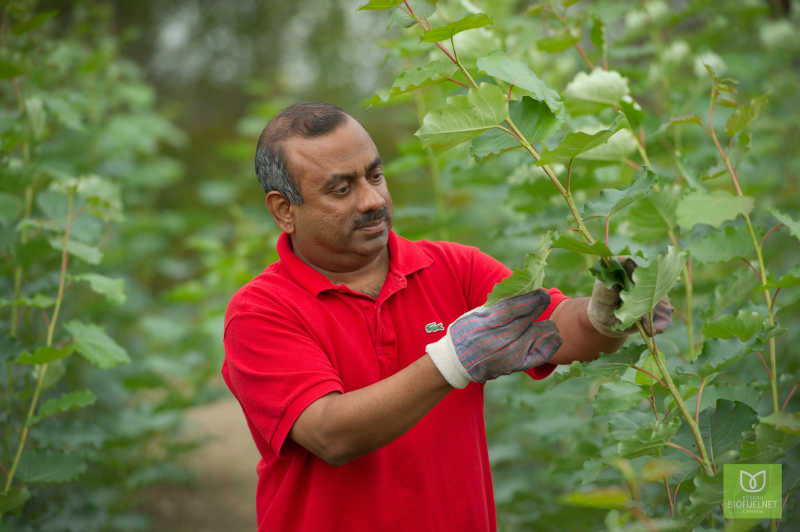Researchers around the globe are investigating ways to lessen our reliance on fossil fuels. Among them are some Canadian researchers studying how switchgrass could one day be used to produce advanced biofuels.
_x000D_
In recent years, the food versus fuel debate has helped spur research into advanced biofuels, which are liquid or gaseous fuels produced through the conversion of biomass consisting of non-food raw materials like grasses and trees._x000D_
_x000D_
As one would imagine, Canada has a wealth of biomass, as well as many agricultural and forestry waste and byproducts that can be used to manufacture biofuels. However, the challenge of determining the right kinds of feedstock and how to convert them into bioenergy efficiently and sustainably is central to the growth of the advanced biofuel industry in this country._x000D_
_x000D_
To this end, Canadian scientists at four different sites in Nova Scotia, Ontario and Alberta have been researching the suitability of purpose-grown switchgrass and poplar trees as feedstock for the production of liquid biofuel since 2014._x000D_
_x000D_
The three-year pan-Canadian trial is funded by BioFuelNet Canada, a network that brings together the Canadian biofuels research community to help unlock the potential of an advanced biofuels industry while focusing on non-food biomass as biofuel feedstocks. Other partners include the Canadian Wood Fibre Centre._x000D_
_x000D_
The four sites in Guelph and Kempville, Ont., Nappan, N.S., and Edmonton, Alta. were chosen to reflect the wide range of growing conditions in Canada. Researchers have been testing two varieties of switchgrass, which is a perennial warm season bunchgrass native to North America, and two clones of hybrid poplar trees in each of the sites to see which are the most and least suitable locations for growing these plants._x000D_
_x000D_
“We are assessing where to grow these crops to get the best economic return. We are growing them in a similar soil type not suitable for any agricultural crops and we are assessing the climatic influence on the growth of these biofuel crops,” says Naresh Thevathasan, a University of Guelph professor who is project leader of the pan-Canadian purpose-grown biomass crops trial._x000D_
Making Use of Marginal Lands
_x000D_
The sites chosen to test the feedstock are classified as Agricultural Capability Class 3 or 4 land, which have lower-grade soils than Class 1 and 2 lands, where most agricultural production takes place. Thevathasan says factors such as low fertility, stoniness and excess sloping makes these marginal lands much less productive for crops like corn and wheat._x000D_
_x000D_
There is, however, a lot of this kind of land in Canada — more than 10 million hectares, according to Thevathasan. He says landowners are experimenting with different uses for these marginal lands, and producing purpose-grown feedstock for bioenergy could be one answer._x000D_
_x000D_
The varieties of switchgrass being grown in the pan-Canadian trials are Cave-In-Rock and Nebraska. Both last up to 15 years after they are seeded, and they could be harvested annually to provide bioenergy feedstock if a commercial market becomes established. According to Thevathasan, some 800 hectares of Cave-In-Rock switchgrass is currently being cultivated in Ontario, but it’s primarily grown as animal bedding material._x000D_
_x000D_
In addition to assessing yield, researchers have been tracking inputs such as herbicide, insecticide and fungicide use as well as fuel and labour costs to help assess the economic return of growing switchgrass in the different locations._x000D_
_x000D_
Thevathasan stresses results from the pan-Canadian trials are still preliminary, but he says of the two varieties, Cave-In-Rock has been generally performing better in three out of the four research site areas in terms of yield (the exception is Edmonton). He adds the findings also indicate growing switchgrass in Canada has some degree of risk; for example, neither of the tested varieties seems to handle snow loading that well._x000D_
_x000D_
In terms of how of the switchgrass fared in different climates, both the Cave-In-Rock and Nebraska varieties have generally performed better at the Nova Scotia and Ontario sites than at the Alberta location north of Edmonton._x000D_
_x000D_
Thevathasan believes these preliminary findings indicate that switchgrass may not be economically viable as a feedstock crop in more northerly latitudes within Canada. He adds he wished the trial could have included a site further south on the Canadian Prairies to assess the suitability of growing switchgrass there._x000D_
_x000D_
Don Smith, scientific director and CEO of BioFuelNet Canada, says future biofuel feedstock trials will likely incorporate different regions as well as a wider range of purpose-grown crops._x000D_
_x000D_
“This is really the first effort to look at particular feedstock crop locations in Canada, and it should start to give us a sense of what crops can be grown where,” he says. “Eventually as things really get going, there’ll be trials here and there all across the country, which will fill in the gaps.”_x000D_
_x000D_
According to Smith, BioFuelNet Canada currently gets $5 a million a year from Ottawa’s Networks of Centres of Excellence (NCE) program and $5 million in matching funding annually from almost 100 industry partners. While BioFuelNet’s funding arrangement with NCE runs out March 31, 2017, Smith is encouraged by funding discussions his organization is having with other government agencies._x000D_
_x000D_
“I think with the pan-Canadian biofuel feedstock trials, no matter what happens, there will be some continued activity there,” he says._x000D_
Early Stages of Industry
_x000D_
_x000D_
Advanced biofuels are still at a very early stage in Canada. Developing the technology to convert biomass into bioenergy and building the facilities to do it is expensive, with the price tag for an advanced biofuels plant running in neighbourhood of a half-billion dollars, according to Smith._x000D_
_x000D_
He acknowledges low oil prices in recent years have probably hampered the industry’s development to some extent. “I think the slump in oil prices has made it more challenging.”_x000D_
_x000D_
However, Smith believes it’s only a matter of time before the fossil fuel era finally comes to an end and renewable energy sources such as advanced biofuels take over. Smith says one encouraging sign is the federal government’s new national carbon pricing policy aimed at reducing greenhouse gas emissions — something he feels should provide a real shot in the arm to the advanced biofuels industry._x000D_
_x000D_
“It’s pretty certain that we’re going to need biofuels for some sectors at least. The long-distance trucking sector is where carbon emissions continue to grow the fastest, so there’s got to be a lot of interest in that,” Smith says. He adds the aviation industry has committed to reducing its carbon emissions dramatically over the long haul, so this is another area where biofuels will likely come into play._x000D_
_x000D_
“All this is going to enhance the use of biofuels, and I think that’s going to be advanced biofuels. We have so much biomass available, especially on a per capita basis, and we really should make use of it,” he says._x000D_
_x000D_
Smith feels that given the country’s vast biomass potential, it’d be a crime if Canada ended up importing advanced biofuels in the future._x000D_
_x000D_
“I think that it really behoves us to make sure that we do what needs to be done to make sure the advanced biofuels industry in Canada develops and flourishes,” he says.












